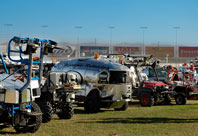|
Join NOVA for an exclusive backstage pass to the DARPA Grand
Challenge—a raucous race for robotic, driverless vehicles
sponsored by the Pentagon, which awards a $2 million purse to the
winning team. Armed with artificial intelligence, laser-guided
vision, GPS navigation, and 3-D mapping systems, the contenders are
some of the world's most advanced robots. Yet even their formidable
technology and mechanical prowess may not be enough to overcome the
grueling 130-mile course through Nevada's desert terrain. From
concept to construction to the final competition, "The Great Robot
Race" delivers the absorbing inside story of clever engineers and
their unyielding drive to create a champion, capturing the only
aerial footage that exists of the Grand Challenge.
It would seem that the essentials to road racing are clear—a
fast car and talented driver, right? Wrong. The Pentagon's Defense
Advanced Research Projects Agency (DARPA) turns this assumption on
its head with its Grand Challenge, a contest solely for autonomous
vehicles that go relatively slowly. Following its success with
unmanned aircraft, DARPA is pushing for the same on-ground advantage
to keep soldiers out of harm's way. Private Jessica Lynch's ambush
in Iraq might well have been avoided if the U.S. Army could have had
a robotic supply truck to carry out missions in dangerous zones.
The program begins with a look back at the first DARPA Grand
Challenge, held in March 2004, an event notable for the sheer number
of things that went wrong. Highlighting the intense complexity of
the task, 15 robots qualified to race, but most barely made it out
of the starting gate. These off-road vehicles applied the term too
literally—pummeling into barriers that protected the crowd,
flipping into ditches, or moving painstakingly forward only to stop
inexplicably when confronted with rocks or brush.
From the time the second race is announced, NOVA immerses itself in
the prerace planning and production. This one-of-a-kind contest
draws bright individuals to a tough technical problem: the design
and construction of thinking machines that read and adjust to
unpredictable terrain without any guidance from their creators.
Nearly 200 teams from around the globe enter, yet only 23 of them
survive the qualifying rounds. Their creations boast names such as
"TerraMax," "Bad Ricky," and "Cajunbot". Behind-the-race footage
takes viewers into the workshops and onto the field (see
Meet the Teams).
Headlining the film is Carnegie Mellon University's "Red Team," led
by Red Whittaker, an ambitious and relentless innovator with
world-renowned expertise in the field of robotics. Under his
leadership, 50 students and professionals give up their personal
lives and outside distractions for an intensive all-out devotion to
not one but two robots—"Sandstorm" and "H1ghlander" (the
latter named for its H1 Hummer body). Pittsburgh's miserable winter
weather makes for long, cold field tests, and 16-hour days are
cushioned by brief bouts of sleep. Through it all, viewers witness
firsthand what Whittaker calls the "violent and wretched time of
birthing a new machine." (See an
outtake of the Red Team
racing in the desert.)
Each team faces the same major tasks, and each goes about them in
its own unique way. An electromechanical system is needed to steer
and brake, and sensors—video, laser, or otherwise—to
"see." The machines must have a software "brain" to process
information, avoid obstacles, and follow the course. Eye-popping
race footage and 3-D animation bring the complex technology to life
and provide a robot's-eye view of the world. (Go to
What Robots See for more on
this.)
Not all the race entrants are high-end machines built by large
corporate-sponsored teams. Taking on the powerhouse Red Team are
many dedicated underdogs, surviving on bare-bones budgets and sheer
determination. "Ghostrider," the only motorcycle entrant, is the
wobbly creation of a lone Berkeley grad student. The cycle's
ingeniously designed ability to right itself after a fall will have
viewers rooting for The Ghost! "Team DAD" consists of two eclectic
brothers who have competed on TV's "Battlebots" and who placed an
impressive third in the first Challenge. Outfitted with a truck,
laptop, and video camera, they are confident that simplicity will
serve them well. NOVA also meets "Stanley," produced by Stanford
University, the contestant most likely to give Carnegie Mellon's
"Sandstorm" and "H1ghlander" a run for their money.
No autonomous vehicles have ever driven so far so fast. As the race
unfolds, NOVA captures the crashes, pitfalls, frustration, fun,
excitement, dirt, determination, and an eventual victory as one
robot wins and several others make it all the way through the
punishing desert course.


|


|
Some of the entrants to the 2005 DARPA Grand Challenge,
which challenged robotic vehicles to complete a rugged
130-mile course in the Nevada desert

|
|
|

